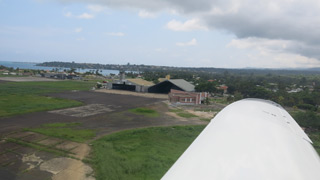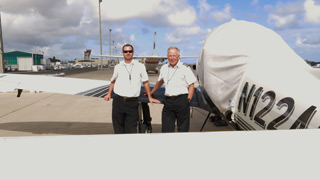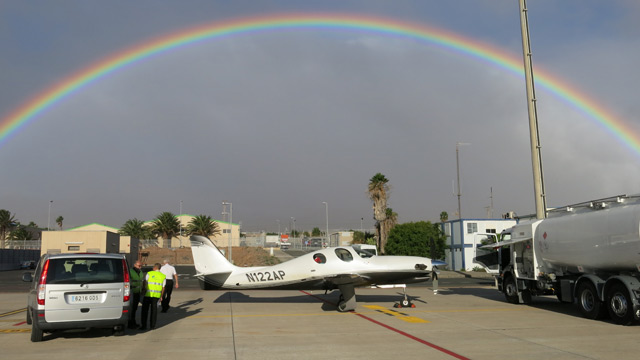
Pilots Bob Jeffrey and David Robinson approached the island of Gran Canaria off Africa's west coast, where they would stumble upon a street festival in their quest for food.
The two ferry pilots had just one goal after the day’s flight leg from Agadir al Massira, Morocco, to the island of Gran Canaria off Africa’s west coast: finding food.
But the hotel where Bob Jeffrey and David Robinson were billeted wasn’t on the main tourist beat, and nearby fast-food choices held little appeal.
They headed out to explore. In a half mile, they noticed a commotion up ahead.
 Flying over Conakry, Guinea.
Flying over Conakry, Guinea.
“We were actually amazed at what we found,” Robinson wrote in a trip blog. “There was a street festival of all local foods and goods which only happens once every three years. There was traditional Spanish food, music, dancing, and lots of local people enjoying the festivities.”
So much for the notion that the pioneer days of aviation are over in the age of owner-built turboprops tracking satellite navigation signals.
Whether they were shedding ice in the flight levels or stumbling on a street festival in the Canary Islands, Jeffrey and Robinson cherish the memories of flying a newly completed Lancair Evolution turboprop single from Redmond, Ore., to Johannesburg, South Africa, where owner Arnold Pistorius waited to take delivery of his aircraft.
 The Lancair also made a stop at Sao Tome.
The Lancair also made a stop at Sao Tome.
The pilots also staked a claim to a little bit of aviation history: The 24-day journey brought the first Lancair Evolution into Africa, Robinson said in a phone interview. And it marked the longest cross-country flown in the kitbuilt aircraft, he said.
The flight also made a good warm-up for their upcoming Evolution delivery flights to Russia and Brazil in 2013.
You need to redefine the term “cross-country” to convey precisely what the two partners in Elite Pilot Services of Bend and Redmond, Ore., accomplished between Oct. 23 and Nov. 16. Jeffrey flew the aircraft from Redmond to the east coast, then across the Atlantic Ocean, picking up Robinson at Biggin Hill Airport outside London, England. The pair flew on to Spain, and then down the African coast, landing 25 times in 18 countries, dodging thunderstorms, fleeing from ice in the flight levels—and sometimes, catching really good tailwinds.
The Evolution performed flawlessly, and there were “zero maintenance issues,” they said.
 David Robinson and Bob Jeffrey at the island of Gran Canaria.
David Robinson and Bob Jeffrey at the island of Gran Canaria.
Before you order the databases and paper charts (they had both) for a similar mission, it might be prudent to note that Jeffrey and Robinson do this sort of thing for a living. They also train pilots in technically advanced aircraft, and provide transition instruction for the move up from piston power to turboprops. That was how they met Pistorius and began flying his aircraft, recently completed with the assistance of Redmond-based Composite Approach.
Still, there’s good news, if you find yourself motivated to consider buying and even building your very own turboprop: Robinson said that most pilots with some experience in a high-performance piston single are good candidates for upgrading to an aircraft like the four-place composite Evolution, that flies comfortably at 300 knots at flight levels in the mid-twenties.
“If someone has flown a Cessna 182 or a Columbia, there’s no problem transitioning,” Robinson said.
A ‘digital kit’
 The 750-shaft-horsepower PT-6A-135A turbine engine-powered airplane is actually easier to fly than a piston aircraft because “there’s much less to operate,” Robinson said. The single power level makes cockpit life easy, but what challenges many transitioning pilots is speed, and having to adjust to thinking about descending from cruise as much as 80 miles from the destination.
The 750-shaft-horsepower PT-6A-135A turbine engine-powered airplane is actually easier to fly than a piston aircraft because “there’s much less to operate,” Robinson said. The single power level makes cockpit life easy, but what challenges many transitioning pilots is speed, and having to adjust to thinking about descending from cruise as much as 80 miles from the destination.
On the subject of pioneering in aviation’s modern age, Lancair describes the aircraft as the first “digital kit” that is based on a software-aided design and constructed with tools and molds that came from the same digital files as the design elements. “Lancair’s core competency lies in carbon composite construction and aerodynamic efficiency, and when this is coupled with the power and reliability of the Pratt & Whitney PT-6 turboprop engine what emerges is an aircraft that is simply unmatched in the certified world,” the company says of the Evolution. Piston-powered Evolutions come with a 350-hp Lycoming engine.
At the conclusion of the flight at Lanseria Airport, in Johannesburg, South Arica, the two pilots had flown the Evolution a combined 13,195 nautical miles in 59.6 flight hours.
The last of the journey’s many adventures occurred on short final in Johannesburg, where Robinson fought off turbulence and wind shear ahead of approaching bad weather to make “his usual grease job” on landing, the blog said.

The two were greeted with a rainbow the morning they departed from the Gran Canaria for Dakar, Senegal.



